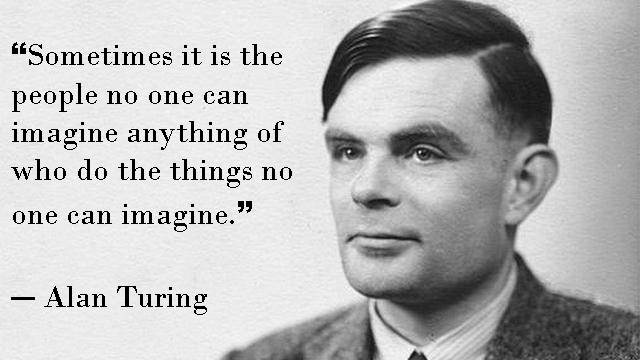Alan Mathison Turing (23 June 1912 – 7 June 1954) known today as the father of modern informatics and artificial intelligence, was a British IT specialist, mathematician, logician, and cryptanalyst. Alan Turing invented a device (the Turing machine) based on the work with the digits 1 and 0, which formalized the concept of algorithm and calculus.

During World War Two, Alan Turing played an important role in the developing of German cypher hacking techniques, along with the team from Bletchley Park, techniques which, according to some historians, saved the lives of millions of people, by shortening the war in Europe with two to four years.
After World War Two, Turing configured one of the first computer programs with stored program – ACE (Automatic Computing Engine), in collaboration with the National Physical Laboratory.
In 1936, Alan Turing invented a hypothetical device, representing a calculus machine, named “a-machine” (automatic machine). A Turing machine helps IT specialists understand the limits of mechanical calculations, by manipulating symbols (according to a table of rules), having the possibility of being adapted to simulate the logic of any computer that can be built.
In 1948, Turing started to collaborate with Man Newman at The Computing Laboratory from Manchester University, where he took part at the development of Manchester computers, and became interested in mathematical biology. During this period he wrote an article on chemical bases of morphogenesis, anticipating the discovery of oscillating chemical reactions (the Beloursov-Jabotinski reaction) which were observed for the first time in 1960. Alan Turing’s primary interest in the field of mathematics’ biology was to understand the Fibonacci phyllotaxis, the existence of Fibonacci numbers in planets’ structures.
In 1950, Turing explored the field of artificial intelligence. He started from the fact that intelligence is hard to define, but we can state that man is intelligent. Hence, if another creature behaves similarly to a human, we could say that it is intelligent. Obviously, not all the elements of human behavior are relevant to intelligence. Decisional power, natural language are linked to intelligence, whilst walking and reproduction are not.
Turing invented the test that carries his name, based on the capacity of a machine to reason. It started from the “imitation game” with three players: a man (A), a woman (B), and a third person (C). C is not in the same room with A and B, and communicating in writing or by a computer terminal, C has to guess which one is the man, and which one is the woman. The role of the first player (A) is to trick the arbiter so that he makes a wrong decision; the role of the other player is to help him make the right one.
Turing replaced the first player (A) with a computer (a computer program), and B and C are two other people. This time, C does not know which of the other two players is the computer, and cannot see them or talk to them directly, and his goal is to differentiate the computer from the person, based on the answers to any type of questions. If C does not succeed, that computer can be considered intelligent. In order to pass a Turing Test well made, the computer needs to use a natural language, reason, to have the necessary knowledge, and to be capable of learning based on previous experiences.
Alan Turing published the paper “Computing Machinery and Intelligence”, which starts with the sentence: “I propose that the question Can machines think? be taken into consideration”, and in which he argued against all objections the idea that “machines can think”. Therefore, in the 1950s, the test proved to be not only extremely influential, but also much-criticized, and represents an essential concept in the artificial intelligence philosophy.
Alan Turing predicted that machines could be capable, in the end, to pass the test; in fact, he estimated that until the year 2000, machines with a memory of 120 MB could trick 30% of the human arbiters in a 5-minute test. He also predicted that machine learning would become an important part of strong machines’ building process, a statement that is considered to be plausible by contemporary researchers.
Alan Turing deceased at the age of 41, on the 7th of June 1954, by poisoning with an apple which was contaminated with cyanide, being found dead in his own home by the maid. It is possible that this is where Steve Jobs found his inspiration for the new logo with the bitten apple (statement denied by the designer of the logo, Rob Janoff).
The A. M. Turing Prize is a distinction awarded annually by Association for Computing Machinery to a person chosen for his technical contributions of high importance brought to the IT community. The Turing Prize is known for being “the highest distinction in IT” or “The Nobel Prize for IT”.
The first laureate was, in 1966, Alan Perlis (from Canegie Institute of Technology), and Frances E. Allen from IBM was the first woman who won this prize, in 2006, after its first 41 years of existence.
The movie “The Imitation Game” (2014) was made about Alan Turing, with Benedict Cumberbatch in the leading role, directed by Mortem Tyldum, based on a book written by Andrew Hodges.
Daniela Anei (translated by Ioana Popescu)